
| What is Flavor and Fortune? |
| How do I subscribe? |
| How do I get past issues? |
| How do I advertise? |
| How do I contact the editor? |
Read 13016823 times
Connect me to:
| Home |
| Articles |
| Book reviews |
| Letters to the Editor |
| Newmans News and Notes |
| Recipes |
| Restaurant reviews |
| Article Index (all years, slow) |
| List of Article Years |
| Article Index (2025) |
| Article Index (last 2 years) |
| Things others say |
| Related Links |
| Log In... |
| Authors |
| Categories & Topics |
Tibetan Dietary Culture
| by Wang Si |
Chinese Ethnic Minorities and Their Foods
Winter Volume: 2009 Issue: 16(4) page(s): 5, 6, 7, and 10
Tibet, which the Chinese call Xizang, is said to be one of the most divine and mysterious places on the earth. Since the establishment of the Qinghai-Tibet railway, economic and cultural exchanges between Tibet and the outside world have increased making goods and foods more available. So more tourists are coming and using and purchasing them; so are more Tibetans. In addition, more and more people are willing to take long-term and short-term jobs, especially in Lhasa, the capital city of Tibet. They add to the many outsiders that now come there. Thus, traditional culture in Tibet is changing, influenced by these many contacts with the outside world. The probability is high, therefore, that their ancient cultural heritage may diminish.
In April 2009, I went to Tibet for the first time. Then, the Dalai Lama wanted self-rule. But I do not think his leadership can maintain Tibet's traditional culture. Why? Because cultures do change; and if Tibet separates from China, cultural exchange between Tibetans and Han Chinese will continue. Nations that show great curiosity and have increased outside influences change naturally. Since this is inevitable, I went there wanting answers to two important questions. The first was: What is life like in Tibet? The second was: Is traditional Tibetan culture vanishing?
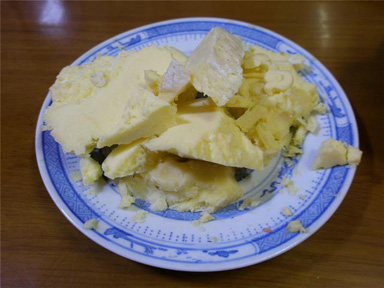 Based on my academic major of dietary culture, this article focuses on agricultural issues, food sources, what Tibetans are eating, their manners, food as it relates to religion, and immigration factors. Because of limited time and economics, only twenty-three days for field research, I studied a select number of Tibetans in Xining, Lhasa and Xigaze. Xining is the capital city of the Qinghai Province; there, more than one-fifth of the population is Tibetan. Lhasa is the capital city of the Tibet Autonomous Region and the largest and most modern city in Tibet. Xigaze is second largest city and it is west of Lhasa.
Based on my academic major of dietary culture, this article focuses on agricultural issues, food sources, what Tibetans are eating, their manners, food as it relates to religion, and immigration factors. Because of limited time and economics, only twenty-three days for field research, I studied a select number of Tibetans in Xining, Lhasa and Xigaze. Xining is the capital city of the Qinghai Province; there, more than one-fifth of the population is Tibetan. Lhasa is the capital city of the Tibet Autonomous Region and the largest and most modern city in Tibet. Xigaze is second largest city and it is west of Lhasa.
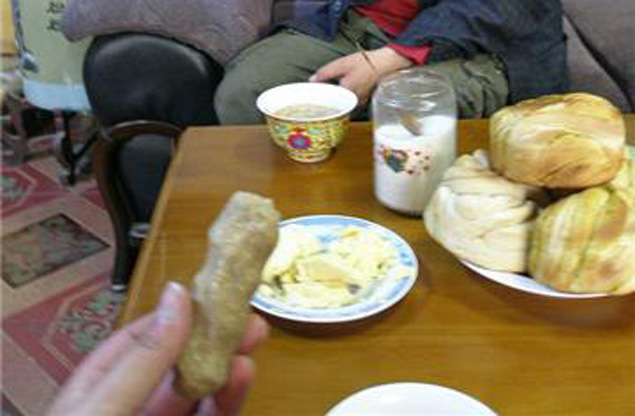 Foods and beverages in Tibet are closely related to the geographic environment. For hundreds of thousands of years, this plateau had a cold and dry climate with a very limited number of the crops including highland barley, winter wheat, green peas, radishes, and potatoes. Tibetans eat sheep, yak and dairy products, so all of these are main sources of traditional Tibetan food. Like the United States where bread is considered a staple food, Tibetans have their basic food, tsampa. This is milled stir-fried highland barley sometimes mixed with milled stir-fried green peas.
Foods and beverages in Tibet are closely related to the geographic environment. For hundreds of thousands of years, this plateau had a cold and dry climate with a very limited number of the crops including highland barley, winter wheat, green peas, radishes, and potatoes. Tibetans eat sheep, yak and dairy products, so all of these are main sources of traditional Tibetan food. Like the United States where bread is considered a staple food, Tibetans have their basic food, tsampa. This is milled stir-fried highland barley sometimes mixed with milled stir-fried green peas.
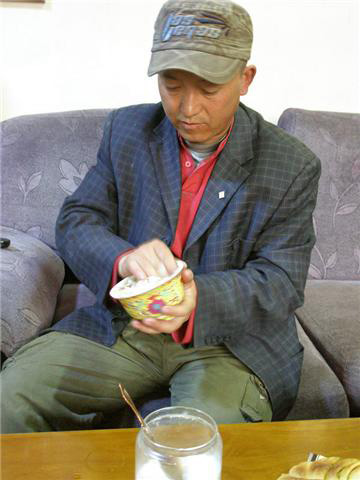 Tibetans have a special way of eating tsampa. They usually put two or three spoons of ground tsampa into butter tea, hold the bowl in the palm of left hand, grab the edge with the thumb of the right hand, and use the rest of the fingers to turn the bowl round and round while whipping the flour and butter tea into paste. It is often made fat and cigar-shaped (and both bowl and tsampa paste are shown on this page). Sugar and cheese can be added, if desired. The end-product tastes a little rough and dry on the throat, and it has a strong butter flavor.
Tibetans have a special way of eating tsampa. They usually put two or three spoons of ground tsampa into butter tea, hold the bowl in the palm of left hand, grab the edge with the thumb of the right hand, and use the rest of the fingers to turn the bowl round and round while whipping the flour and butter tea into paste. It is often made fat and cigar-shaped (and both bowl and tsampa paste are shown on this page). Sugar and cheese can be added, if desired. The end-product tastes a little rough and dry on the throat, and it has a strong butter flavor.
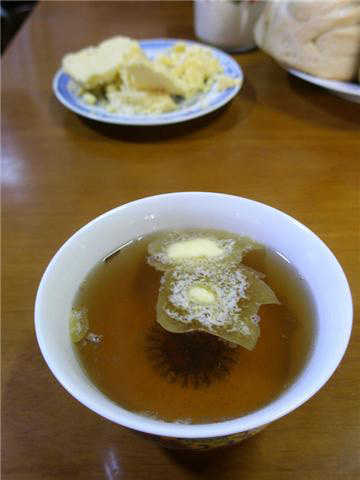 An important drink in their daily life is butter tea which is also pictures with this article. It is made of yak butter and brick tea. In the past, people put boiled brick tea in a special tea-churn which is made of hollowed out wood with a plunger. They put butter and salt into this tea-churn and pushed the plunger again and again, about sixty times, until all was adequately mixed. Then they had their butter tea. Nowadays, electronic churns are widely used instead of those made of wood. These produce better butter tea and in a more convenient way.
An important drink in their daily life is butter tea which is also pictures with this article. It is made of yak butter and brick tea. In the past, people put boiled brick tea in a special tea-churn which is made of hollowed out wood with a plunger. They put butter and salt into this tea-churn and pushed the plunger again and again, about sixty times, until all was adequately mixed. Then they had their butter tea. Nowadays, electronic churns are widely used instead of those made of wood. These produce better butter tea and in a more convenient way.
Since the Tang Dynasty (618 - 907 CE), tea has become a most important beverage for every Tibetan resident. In Xining City, I stayed in a lama's house near the Kumbum Monastery. That lama, Yinba Jiancuo, told me that as the water quality is not so good, cholelithiasis, which is a gall bladder irritation, has become widespread in Qinghai. Now, they drink only boiled water, and instead consume lots of brick tea.
Tibetan monks have no taboos about eating beef and mutton. Shakyamuni Buddha might be silently consenting, as living in a cold dry plateau with less simple food, vegetables alone are not adequate. Butter tea supplies high calories and proteins as well. Furthermore, it helps digesting, reduces body fat, and prevents skin and lips from chaffing and chapping in the cold.
Sweet tea is another drink, but it is seldom served at home. Actually, it originated from milk tea in England, and has been popular since the 1920's when Tibetan military followed the habits of Englishman. In the past several decades, consuming this tea with milk in it has become more and more prevalent in cities and towns.
In cities and in the countryside, tea houses play an important role in Tibetans social life. They mainly serve typical sweet tea and Tibet-style-noodles. People gather and can spend half day in them. One of the biggest and famous of these tea houses is in Lhasa is in Danjielin Alley, Barkhor Square. It is named Guangming Shangdian Tea House and the outside and inside are shown with this article. It is a little exclusive and Han people are rarely seen there.
Once I went to this tea house at noon and found people sitting everywhere, including on the floor. They were very casual, whether rich or poor as assessed by their dress. It was interesting that customers drew out small notes of one yuan or half a yuan and put them on the table. A waiter or waitress would arrive with a big kettle and serve them sweet tea costing half yuan per cup. Most of the customers were male, and it seems females preferred to go to small tea houses and chat and knit with three or four of their female friends.
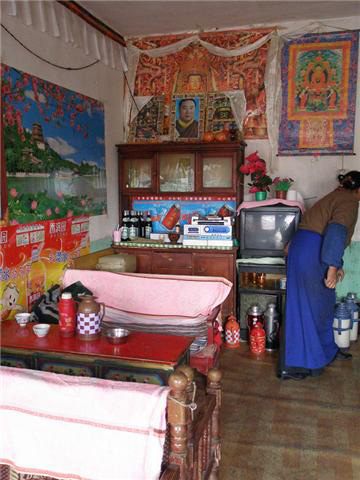 Sweet tea in small tea houses can be ordered by thermos for three pounds which is six yuan, or five pounds or eight yuan. A tea house is shown on these pages, too. At meal times, people also order a bowl of Tibet-style-noodles. They often come with a small dish of pickled radishes. The noodles are very tasty and most come in thick yak soup with chopped beef and shallots. Compared with butter tea and tsampa, sweet tea and Tibet-style-noodles are more acceptable among Han people and other tourists, too.
Sweet tea in small tea houses can be ordered by thermos for three pounds which is six yuan, or five pounds or eight yuan. A tea house is shown on these pages, too. At meal times, people also order a bowl of Tibet-style-noodles. They often come with a small dish of pickled radishes. The noodles are very tasty and most come in thick yak soup with chopped beef and shallots. Compared with butter tea and tsampa, sweet tea and Tibet-style-noodles are more acceptable among Han people and other tourists, too.
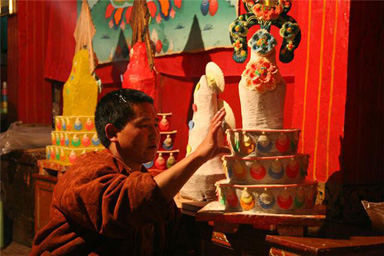 With the resent development of improved transportation, economic and trade exchanges with mainland China have become more frequent. Various external foods are flowing into Tibet. Some are factory products like instant noodles, biscuits, soda, beer and various canned foods. Some are of traditional Han nationality items such as rice, steamed buns, noodles, and other sorts of the Han Chinese Cuisine. Thus, traditional diets are changing in some ways.
With the resent development of improved transportation, economic and trade exchanges with mainland China have become more frequent. Various external foods are flowing into Tibet. Some are factory products like instant noodles, biscuits, soda, beer and various canned foods. Some are of traditional Han nationality items such as rice, steamed buns, noodles, and other sorts of the Han Chinese Cuisine. Thus, traditional diets are changing in some ways.
In Xigaze, I stayed with a Tibetan family whose living standard was above average. I found that the content of their daily diet no longer simple. They usually had tsampa and butter tea for breakfast. Rice and several stir-fried dishes were often served for lunch. In the evening they ate some steamed buns, noodles, or Tibet-style-dumplings which they call momo. Not everyone liked the same foods there. The seventy-year-old grandma preferred traditional food, while the nine-year-old grandson was more inclined to eat rice. He admitted he liked soda, too. The thirty-one-year-old mother implied that she did like preparing diverse foods for her family. All its members at least agreed on one thing, that it is impossible to live without tsampa and butter tea.
During this decade, restaurants are increasing in Tibet. This is true not only for tourists, but for some Han Chinese and the many Tibetans living there. Almost one-quarter are operated by people from the Sichuan Province.
Why is this so? The Sichuan Province has the largest population in China; and it provides the largest labor outflow in China. Many Tibetans are fond of Sichuan food as this cuisine adapts to Tibetan tastes for it is hot and spicy, and it provides more energy for those living at high altitudes. Spicy foods enrich the flavor of simple food and rarely require fresh materials.
Other popular dishes in Tibet, according to my inquiries, are wheat flour foods such as those found in Dongbei and Shanxi restaurants, and chicken dishes served in Uygur restaurants.
There is a popular saying in Tibet: "Females get callus on their palms while males get them on their hips." Nowadays in Tibet, women are often seen carrying heavy loads. Housework is still always done by females, and generally one finds more female employees in tea houses than males.
Males, except when working, spend lots of time in tea houses and bars. Tibetan barley wine was prevalent in the old times, but nowadays, it appears mostly at weddings, funerals, and traditional festivals. Beer has a larger market share now. A Tibetan driver employed in a Lhasa travel service told me that his favorite hobby is to drink beer in bars with his brother and friends. Another official worker, in the Xigaze Farming Authority, said he likes beer rather than liquor. A survey done in a local bar indicated that Lhasa, Carlsberg, and Budweiser are the most three most popular brands of alcoholic beverages.
Apparently, convenient transportation, favorable policies, and the ideas and customs of immigrants have influenced Tibetan life. This does not mean Tibetan cultural heritage is vanishing. Their vigorous religious culture and its close relationship with traditional foods seem to be keeping it.
What I felt when there, made me believe that experiencing culture is far better than any descriptions of it. On my way to Lhasa from Xining, the train travelled into Ngari Prefecture where the elevation is above five thousand meters. Through the train windows, I saw some wild yaks and antelopes. One can not help but believe that this is a place where even oxygen is a scarce resource. No wonder Tibetans always feel deeply grateful to their gods. Despite the poor fields and the cold dry climate, they are willing to contribute highland barley and butter as the very best things for gods. In temples and monasteries, foods are their important sacrifices. Different from other sects, Tibetan Buddhism uses butter as fuel instead of candles. Thus you see many butter lamps in Tibetan temples and monasteries.
When I visited the Jokhang Temple, I was surprised by the streams of pilgrims. As the first temple of Lhasa, Jokhang remains the pilgrimage center of Tibetan Buddhism. The incredible head-to-feet prostrated people are very common here and everywhere. Some of them were prostrating along the way far from their villages, using their bodies to measure the whole course in order to show holy respect. Inside the temple, I saw crowds of orderly pilgrims walking along its statues one by one, and almost everyone carrying a thermos filled with yak butter. When close to a butter lamp, they would pour some butter into the square vessel, so that the lamp would never go out. Thus the whole temple was filled with a strong smell of butter.
As far as I know, yak butter costs twenty-five yuan per kilo in Lhasa. Not only is it used for lighting, but there is also another religious use called butter sculpture. For this, butter mixed with mineral dye is used to make sculptures of Buddha or Buddhist stories for religious celebrations. This is an old art in Tibet probably beginning during their Tubo Era which was in the Tang Dynasty. Then, Princess Wencheng married Songtsen Gampo in Lhasa and brought with her a Shakyamuni statue. It is now in the Jokhang Temple. Tibetans believe that in winter, flowers should be offered to Shakyamuni, but they could not find any at that time of year, so smart folk made a bunch of butter flowers instead. Years later, butter sculptures continue as offerings by monks. In some monasteries, artistic monks undertake this work. The Lama Yinba Jiancuo in Kumbum Monastery is one of the famous contemporary artistic ones. Butter's melting point is about twenty-five degrees, therefore, sculptures can go out of shape when the temperature goes above fifteen degrees. Making butter sculptures is difficult and a complicated traditional craft from preparation to display. Most procedures have to be done at low temperatures. This can deform the fingers that do it. Still, monks consider it a holy job and they want to constantly advance and enrich this kind of old art.
On Tibetan New Years Day, every family offers sacrifices in front of shrines. They give grains, wheat straws, butter, cheese, barley wine, candies and dried fruit. Every family hangs a cattle skull on their door for good luck. The whole body of yak and goat used to be sacrificed in temples. I was told by a local that before New Year's Day, they use milk and sugar mixed with lime to paint the white wall of Potala Palace so as to show their great sincerity.
Since most Tibetans are very religious and believe in Buddha and other gods, and since religion is still the basic and major part of their spiritual life, how could they not participate in a traditional life style? Even though culture changes for many reasons and more people are showing greater tolerant to differences, many are more concerned and interested in past religious characteristics; some even practicing them.
Like Tibetans, people everywhere are attracted by various life styles. Butter-tea and tsampa will remain to identify this unique ethnic group. They say "without butter-tea and tsampa, one can not be a real Tibetan" and they suggest to outsiders to "try more tsampa so you will talk like a real Tibetan."
There are economic reasons, too. As a famous destination, many goods are transported there from elsewhere and their consumption level is higher than before. Many immigrants complain about that while Tibetans seem not to, probably for three reasons. One is the emergence of some wealthy locals who, as far as I know, most are government officers. Another reason is their butter-tsampa diet. Hardly any immigrants get used to the rancid flavor of yak butter and the rough texture of tsampa, so they hardly demand these items which, if they did, could lead to inflation of Tibetan food. Still another reason is that Tibetan simple healthy diets are related to their firm religious beliefs. That helps them keep their traditional foods and eating behaviors.
_____
Wang Si was born in Hubei, China, and is studying for her master's degree specializing in Chinese dietary culture at Zhejiang Gongshang University in Hangzhou, China. Her interests are comparative cultures and cultural anthropology on dietary culture.

Copyright © 1994-2025 by ISACC, all rights reserved
Address
3 Jefferson Ferry Drive
S. Setauket NY 11720